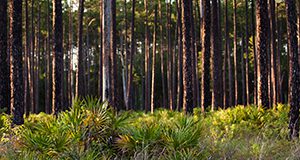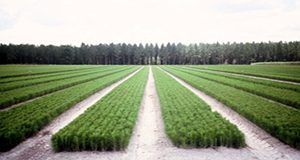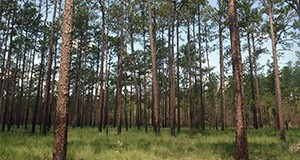This 4-page publication presents a straightforward and intuitive approach based on compounding costs to determine the timber value of a forest at any stage of its development. Written by Andres Susaeta, and published by the UF/IFAS School of Forest, Fisheries, and Geomatics Sciences, March 2021.
https://edis.ifas.ufl.edu/fr435
Tag: Forest Management and Stewardship
Marking First Thinnings in Pine Plantations: Potential for Increased Economic Returns

This 3-page fact sheet written by Byron Love, Michael Andreu, and Chris Demers and published by the UF/IFAS School of Forest Resources and Conservation summarizes a study to determine whether landowners may gain increased economic returns if they mark the first thinning in a southern pine stand. The study found that marking can indeed bring higher revenue at final harvest. The greater number of high-quality and faster-growing trees remaining after a marked thinning is the main reason for immediate and future increases in value.
http://edis.ifas.ufl.edu/fr410
Genetically Improved Pines for Reforesting Florida's Timberlands
Just as farmers plant the best-available varieties of crops that have been developed through many generations of breeding, forest landowners should plant the best-available genetically improved varieties of pines for reforestation of their timberlands. This 8-page fact sheet written by Timothy L. White, Mary L. Duryea, and Gregory L. Powell and published by the UF/IFAS School of Forest Resources and Conservation explains how planting genetically improved varieties of pines can increase the productivity, health, and value of reforested Florida timberlands.
edis.ifas.ufl.edu/fr007
Florida's Forest Stewardship Program: An Opportunity to Manage Your Land for Now and the Future
The Forest Stewardship Program encourages landowners to manage their lands for multiple natural resources, increases public awareness of the importance of Florida’s forestlands, and improves cooperation among natural resource agencies and organizations to meet Florida’s forest resource conservation and management needs. This three page fact sheet written by Mary Duryea, Deborah McGrath, Chris Demers, and Anthony Grossman and published by the School of Forest Resources and Conservation explains the program and its benefits and describes how to become a forest steward.
http://edis.ifas.ufl.edu/fr408
Timber Production in a Working Forest Context
Working forests are private forests managed not just for timber production but also for a host of valuable ecosystem services like providing for recreation, maintaining habitat for wildlife, and maintaining a healthy watershed. Timber production is an essential ecosystem good or service that supports a number of important industries and provides jobs in Florida. This 6-page fact sheet summarizes the results of several studies to help forest landowners and other stakeholders understand how multiple-use management affects both timber production and other ecosystem services.
http://edis.ifas.ufl.edu/fr406
Improving, Restoring, and Managing Natural Resources on Rural Properties in Florida: Sources of Financial Assistance
Interested in conserving natural resources, such as wildlife habitat, or protecting the agricultural heritage of your land? Both federal and state governments have technical and financial assistance programs to help rural landowners achieve natural resource goals. These challenges are addressed through land rentals, technical assistance, cost-shares, and incentive payments and include both time-limited and permanent land-use options.
This 8-page fact sheet written by Chris Demers, Martin B. Main and Mark E. Hostetler and published by the UF School of Forest Resources and Conservation informs landowners about government programs available to help conserve natural resources.
http://edis.ifas.ufl.edu/fr156
An Overview of Carbon Markets for Florida Forest Landowners
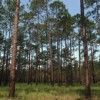 Payments for sequestering carbon in forests can be an important supplemental income source in the southern US which includes one-third of the contiguous US forest carbon stocks and supplies 16% of the world’s wood. It is difficult to understand the carbon market and certification options available to Florida forest landowners and the possible risks of participating in them. To address this need, UF/IFAS forest management specialists provide this overview of forest carbon markets in the United States as of 2014 and compare key features of the four major carbon offset certification options. This 9-page fact sheet was written by José R. Soto, Francisco J. Escobedo, and Damian C. Adams, and published by the UF Department of School of Forest Resources and Conservation, July 2014.
Payments for sequestering carbon in forests can be an important supplemental income source in the southern US which includes one-third of the contiguous US forest carbon stocks and supplies 16% of the world’s wood. It is difficult to understand the carbon market and certification options available to Florida forest landowners and the possible risks of participating in them. To address this need, UF/IFAS forest management specialists provide this overview of forest carbon markets in the United States as of 2014 and compare key features of the four major carbon offset certification options. This 9-page fact sheet was written by José R. Soto, Francisco J. Escobedo, and Damian C. Adams, and published by the UF Department of School of Forest Resources and Conservation, July 2014.
http://edis.ifas.ufl.edu/fr387
Florida Forest Landowner Preferences for Carbon Offset Program Characteristics
 This 7-page fact sheet explains how carbon-offset programs operate and examines their benefits to landowners and the environment, especially in Florida and the southeast US. A summary of a recent study of Florida forest landowners is used to better reveal views on forest carbon-offset programs and their willingness-to-accept monetary compensation for their enrollment in such programs. Written by José R. Soto, Damian C. Adams, and Francisco J. Escobedo, and published by the UF Department of School of Forest Resources and Conservation, July 2014.
This 7-page fact sheet explains how carbon-offset programs operate and examines their benefits to landowners and the environment, especially in Florida and the southeast US. A summary of a recent study of Florida forest landowners is used to better reveal views on forest carbon-offset programs and their willingness-to-accept monetary compensation for their enrollment in such programs. Written by José R. Soto, Damian C. Adams, and Francisco J. Escobedo, and published by the UF Department of School of Forest Resources and Conservation, July 2014.
http://edis.ifas.ufl.edu/fr388
Conservation Easements: Options for Preserving Current Land Uses
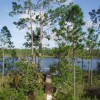 Conservation easements are cost-effective means for government agencies or non-government conservation organizations to protect land. Instead of purchasing land outright, these agreements allow organizations to purchase the development rights of a property. This protects the land and saving money. Landowners who choose this option prevent future residential and commercial development of their land, and reduce the amount of inheritance tax liability. Landowners are encouraged to enter such agreements carefully because they require several rights to be conveyed to the easement grantee and the duration of these agreements is typically perpetual. This 5-page fact sheet describes conservation easements, what is involved in establishing one, tax implications, participating government and non-government organizations, and important considerations for landowners. Written by Chris Demers and Douglas R. Carter, and published by the UF Department of School of Forest Resources and Conservation, March 2014.
Conservation easements are cost-effective means for government agencies or non-government conservation organizations to protect land. Instead of purchasing land outright, these agreements allow organizations to purchase the development rights of a property. This protects the land and saving money. Landowners who choose this option prevent future residential and commercial development of their land, and reduce the amount of inheritance tax liability. Landowners are encouraged to enter such agreements carefully because they require several rights to be conveyed to the easement grantee and the duration of these agreements is typically perpetual. This 5-page fact sheet describes conservation easements, what is involved in establishing one, tax implications, participating government and non-government organizations, and important considerations for landowners. Written by Chris Demers and Douglas R. Carter, and published by the UF Department of School of Forest Resources and Conservation, March 2014.
http://edis.ifas.ufl.edu/fr149
Stewardship Ecosystem Services Study Series: Assessing Forest Water Yield and Purification Ecosystem Services in the Lower Suwannee River Watershed, Florida
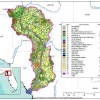 Land-use decisions and ecosystem characteristics affect the amounts of nutrients that end up in water bodies and the ability of the land to provide ecosystem services. Water quality is also highly valued by Florida forest landowners and managers. So, understanding the role of land use and forest cover and types, management practices, and conservation programs in reducing nutrient pollution will allow landowners, forest managers, and policy makers to make informed and better management decisions. In this 6-page fact sheet, we present the results of a study that used easily available models and information to assess the role of forests in providing ecosystem services, including water quality improvement or purification. Specifically, this assessment used available geospatial data and the InVEST Water Purification model to estimate how forest vegetation and soils purify water through the retention, and subsequent export, of nitrogen and phosphorus polluted runoff. Written by Sonia Delphin, Francisco J. Escobedo, Amr Abd-Elrahman, Alison E. Adams, Jackie Martin, Ronald Cademus, and published by the UF Department of School of Forest Resources and Conservation, January 2014.
Land-use decisions and ecosystem characteristics affect the amounts of nutrients that end up in water bodies and the ability of the land to provide ecosystem services. Water quality is also highly valued by Florida forest landowners and managers. So, understanding the role of land use and forest cover and types, management practices, and conservation programs in reducing nutrient pollution will allow landowners, forest managers, and policy makers to make informed and better management decisions. In this 6-page fact sheet, we present the results of a study that used easily available models and information to assess the role of forests in providing ecosystem services, including water quality improvement or purification. Specifically, this assessment used available geospatial data and the InVEST Water Purification model to estimate how forest vegetation and soils purify water through the retention, and subsequent export, of nitrogen and phosphorus polluted runoff. Written by Sonia Delphin, Francisco J. Escobedo, Amr Abd-Elrahman, Alison E. Adams, Jackie Martin, Ronald Cademus, and published by the UF Department of School of Forest Resources and Conservation, January 2014.
http://edis.ifas.ufl.edu/fr385
The Green Value of Your Woods: A Summary of Ecosystem Services Provided by Forest Stewardship Lands in Florida
 Lands enrolled in voluntary forest management and conservation programs, like the Forest Stewardship Program, promote good land management practices. In addition to benefiting the landowners enrolled in these programs, good land management provides ecosystem services to society. The Stewardship Ecosystem Services Survey calculated the physical and economic benefits of water resource protection, carbon sequestration and storage, timber production, and wildlife conservation. This 2-page fact sheet was written by Rose Godfrey, Chris Demers, Francisco Escobedo, Damian Adams, and Michael Andreu, and published by the UF Department of School of Forest Resources and Conservation, September 2013.
Lands enrolled in voluntary forest management and conservation programs, like the Forest Stewardship Program, promote good land management practices. In addition to benefiting the landowners enrolled in these programs, good land management provides ecosystem services to society. The Stewardship Ecosystem Services Survey calculated the physical and economic benefits of water resource protection, carbon sequestration and storage, timber production, and wildlife conservation. This 2-page fact sheet was written by Rose Godfrey, Chris Demers, Francisco Escobedo, Damian Adams, and Michael Andreu, and published by the UF Department of School of Forest Resources and Conservation, September 2013.
http://edis.ifas.ufl.edu/fr381
Tips for Integrating Land and Wildlife Management: Deer in Forests (WEC329/UW374)
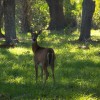 Prized by hunters and wildlife enthusiasts alike, white-tailed deer are a popular species found throughout Florida. As such, they are often the focus of management for landowners, managers, and lessees who want to improve deer populations while maintaining other land uses such as timber production. This 2-page fact sheet provides some deer habitat improvement tips that focus primarily on raising the quality of deer forage but that also will help you grow better cover by improving plant diversity and productivity. Written by William M. Giuliano, John M. Olson, and Cailey Thomas, and published by the UF Department of Wildlife Ecology and Conservation, January 2013.
Prized by hunters and wildlife enthusiasts alike, white-tailed deer are a popular species found throughout Florida. As such, they are often the focus of management for landowners, managers, and lessees who want to improve deer populations while maintaining other land uses such as timber production. This 2-page fact sheet provides some deer habitat improvement tips that focus primarily on raising the quality of deer forage but that also will help you grow better cover by improving plant diversity and productivity. Written by William M. Giuliano, John M. Olson, and Cailey Thomas, and published by the UF Department of Wildlife Ecology and Conservation, January 2013.
http://edis.ifas.ufl.edu/uw374
Using Soils to Guide Fertilizer Recommendations for Southern Pines (CIR1230/FR053)
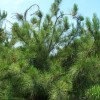 Soils supporting southern pine stands in the South tend to be infertile and nutrient additions are often required to achieve optimum rates of production. This 12-page publication describes and classifies soils of the southeastern Coastal Plain region and specifically addresses issues of fertility, growth-limiting nutrients, and fertilizer recommendations for southern pines. Written by Eric J. Jokela and Alan J. Long, and published by the UF Department of School of Forest Resources and Conservation, June 2012.
Soils supporting southern pine stands in the South tend to be infertile and nutrient additions are often required to achieve optimum rates of production. This 12-page publication describes and classifies soils of the southeastern Coastal Plain region and specifically addresses issues of fertility, growth-limiting nutrients, and fertilizer recommendations for southern pines. Written by Eric J. Jokela and Alan J. Long, and published by the UF Department of School of Forest Resources and Conservation, June 2012.
http://edis.ifas.ufl.edu/fr053
Beyond the Trees: A Systems Approach to Understanding Forest Health in the Southeastern United States (FOR287/FR355)
 Forest health is an important topic for biology, agriculture, current issues, and environmental science classes. But conversations with educators suggested that they were not equipped to teach about it given their existing curricula. This 79-page educator guide includes six activities designed to help learners consider forest health from various viewpoints; understand interrelationships and feedback mechanisms in a forest system; visualize spatial and temporal mechanisms of forest system functions; appreciate the variety of threats to forest health; and consider their role as future forest stewards. Written by Geetha S. Iyer, Martha M. Monroe and Jason A. Smith, and published by the UF Department of School of Forest Resources and Conservation, July 2011.
Forest health is an important topic for biology, agriculture, current issues, and environmental science classes. But conversations with educators suggested that they were not equipped to teach about it given their existing curricula. This 79-page educator guide includes six activities designed to help learners consider forest health from various viewpoints; understand interrelationships and feedback mechanisms in a forest system; visualize spatial and temporal mechanisms of forest system functions; appreciate the variety of threats to forest health; and consider their role as future forest stewards. Written by Geetha S. Iyer, Martha M. Monroe and Jason A. Smith, and published by the UF Department of School of Forest Resources and Conservation, July 2011.
http://edis.ifas.ufl.edu/fr355
Pre-Commercial Thinning Loblolly Pines: Does It Pay? (FOR188/FR243)

The decision to pre-commercially thin a stand is often difficult for many landowners because of the costs involved with implementing this treatment. It is costly but, when applied properly, it is a financially attractive investment. It is performed before trees reach merchantable size, to reduce densities in overstocked stands and improve the growth of the remaining trees. This 6-page fact sheet was written by R. Williams, K. Bohn, J. McKeithen and C. Demers, and published by the UF Department of School of Forest Resources and Conservation, May 2011.
http://edis.ifas.ufl.edu/fr243
Conservation Easements: Options for Preserving Current Land Uses (SSFOR21/FR149)
Many landowners have a strong connection to their land and want to ensure its protection for many generations. Conservation easements can prevent future residential and commercial development of one’s land, and reduce inheritance tax liability for one’s heirs. This 6-page fact sheet will describe conservation easements, what is involved in establishing one, some of the tax implications of such agreements, the government and non-government organizations that commonly participate in conservation easements, and important considerations for landowners before entering into such an agreement. Written by Chris Demers and Douglas R. Carter, and published by the UF School of Forest Resources and Conservation, March 2011.
http://edis.ifas.ufl.edu/fr149
SSFOR13/FR064 Longleaf Pine Regeneration
SSFOR13, a 8-page fact sheet by Chris Demers, Alan Long and Patrick Minogue, provides landowners with long-term, multiple-use resource management objectives with strategies for artificial and natural regeneration of this insect-, disease- and fire-resistant species. Includes references. Published by the UF Department of School of Forest Resources and Conservation, November 2010.
http://edis.ifas.ufl.edu/fr064
AE464 El Uso de los Pronósticos de la Variabilidad Climática Estacional para Planificar el Establecimiento de la Plantación de Bosques
AE464, a 3-page fact sheet by Norman Breuer, Matthew Langholtz, David Zierden and Clyde Fraisse, is the Spanish language version of ABE354/AE282: Using Seasonal Climate Variability Forecasts to Plan Forest Plantation Establishment. It provides strategies to consider for pine plantation establishment in Florida and southern Alabama and Georgia, where seasonal climate conditions can be better predicted because it is affected by the El Niño Southern Oscillation (ENSO) phenomenon. Includes references. Published by the UF Department of Agricultural and Biological Engineering, July 2010.
http://edis.ifas.ufl.edu/ae464
WEC274/UW319 Ten Tips for Increasing Wildlife Biodiversity in Your Pine Plantations
WEC274, a 4-page fact sheet by Holly K. Ober, Stanton Rosenthal, and William Sheftall, discusses strategies forest landowners may adopt to provide habitat that will attract a diversity of wildlife species to their land. Includes references. Published by the UF Department of Wildlife Ecology and Conservation, December 2009.
http://edis.ifas.ufl.edu/uw319
SSFOR17/FR130 Steps to Marketing Timber
Revised! SSFOR17, a 7-page fact sheet by Chris Demers and Alan Long, provides forest landowners some important guidelines to follow when planning and conducting a timber sale. Includes references. Published by the UF School of Forest Resources and Conservation, February 2010.
http://edis.ifas.ufl.edu/fr130
